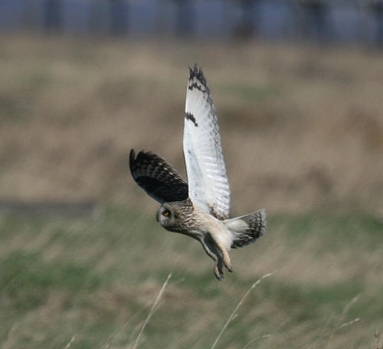Short-eared Owl

Short-eared Owls are a feature of Arran moorlands.
Unlike other owls, the Short-eared owl habitually hunts by day. Most hunting occurs during early morning and evening but, if the food supply is low, then the birds are more often seen throughout the day. At rest, the ear tufts are hard to see but the yellow eyes are distinctively encircled by black, which give the bird a glaring stare. In flight, as it quarters the ground hunting for voles, the undersides of the wings show black wing tips, white trailing edges and a distinctive dark carpal patch (about half way along the leading edge of the wing) that is more prominent than in the Long-eared Owl.
In Scotland the birds usually move between separate breeding and wintering areas. Many Scottish birds move south, even to southern Europe, in the winter; at the same time, the Scottish population is supplemented by birds coming from northern Europe. On Arran, this owl is a restricted resident breeder with the birds normally returning to their breeding areas in early March.
Short-eared Owls breed in open rough country with low levels of disturbance and a high population of small rodents, particularly field voles. The Short-eared Owl population fluctuates markedly depending on the prevalence of prey and the availability of suitable habitat.
Some time ago, my postman stated that it had been a long time since he had seen a Short-eared Owl whereas previously he used to see them every day. This made me look more closely at recent records. In 2007, I received sixteen sightings of Short-eared Owl, eight of these from the Machrie Moor Road, and none were after the 2 September. This year until the end of March there has been one sighting, again in Machrie.
If you do see Short-eared Owls, please take a moment to report the sighting to me, so our records can be as comprehensive as possible and our understanding of this stunning bird can be improved.
Published in the Arran Banner in 2008